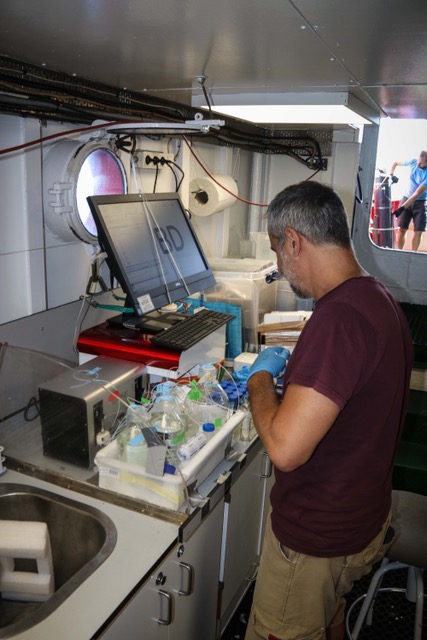Counting bacteria in the ocean faster than ever: automated flow cytometry
By Massimo C. Pernice and Josep M. Gasol
 Bacteria are fundamental in marine ecosystems, playing key roles in nutrient cycling and food webs; for this reason, it is particularly important to quantify their number in the ocean. Counting them under the microscope is similar to counting stars, a beautiful but really tedious job, but luckily, researchers can use a machine named flow cytometer that helps in this task. The flow cytometer sucks and squeezes the water sample in a narrow flow that passes in front of a laser, and every time that a bacterium passes, the machine will count it. In order to see bacteria, we have to “paint” them with a special stain that binds to their genetic material and emits green light when excited by a blue laser. The problem is that on oceanographic sampling cruises, flow cytometry data are usually collected with bottles in stations separated by kilometers, leading to a fragmented view of natural bacterial communities. In this study, we proposed the application of an automatic method of sampling, staining and counting bacteria to improve the resolution of the datasets produced. The system consists of a flow-cytometer connected to an automated sampler that collects samples of surface seawater every 15 min by a faucet linked to an inlet pump (5 m depth), and was tested for five days during a Mediterranean cruise. We managed to collect, stain and read up to 366 samples in a completely automated way, allowing us to observe large variations in bacterial abundance in relatively short distances and over a day cycle, which indicates a large heterogeneity in bacterial communities that could remain undetected with non-automated sampling. Due to its high-resolution, this set-up shows great potential both to cover large sampling areas, and to monitor day-night cycles in situ.
Bacteria are fundamental in marine ecosystems, playing key roles in nutrient cycling and food webs; for this reason, it is particularly important to quantify their number in the ocean. Counting them under the microscope is similar to counting stars, a beautiful but really tedious job, but luckily, researchers can use a machine named flow cytometer that helps in this task. The flow cytometer sucks and squeezes the water sample in a narrow flow that passes in front of a laser, and every time that a bacterium passes, the machine will count it. In order to see bacteria, we have to “paint” them with a special stain that binds to their genetic material and emits green light when excited by a blue laser. The problem is that on oceanographic sampling cruises, flow cytometry data are usually collected with bottles in stations separated by kilometers, leading to a fragmented view of natural bacterial communities. In this study, we proposed the application of an automatic method of sampling, staining and counting bacteria to improve the resolution of the datasets produced. The system consists of a flow-cytometer connected to an automated sampler that collects samples of surface seawater every 15 min by a faucet linked to an inlet pump (5 m depth), and was tested for five days during a Mediterranean cruise. We managed to collect, stain and read up to 366 samples in a completely automated way, allowing us to observe large variations in bacterial abundance in relatively short distances and over a day cycle, which indicates a large heterogeneity in bacterial communities that could remain undetected with non-automated sampling. Due to its high-resolution, this set-up shows great potential both to cover large sampling areas, and to monitor day-night cycles in situ.Read the full study here:
Pernice, M. C. & Gasol, J. M. Automated flow cytometry as a tool to obtain a fine-grain picture of marine prokaryote community structure along an entire oceanographic cruise. Front. Microbiol. 13, (2023).
Text written by Massimo C. Pernice and edited by Clara Ruiz and Félix Picazo
